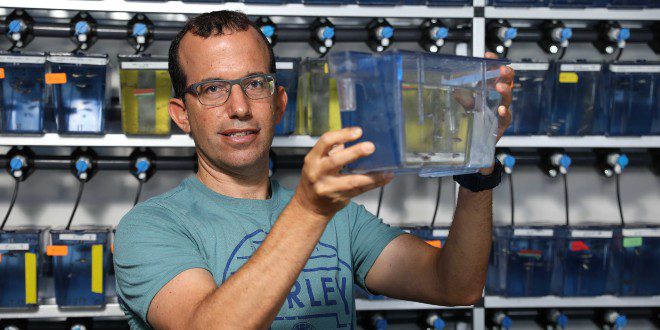We start to yawn, rub our eyes, whose eyelids begin to close. Is that how we know we’re tired and ready for bed? For what purpose do we sleep, besides the fact that we’re exhausted?
A new study at Bar-Ilan University (BIU) in Ramat Gan (near Tel Aviv) reveals that the PARP1 (Poly ADP-Ribose Polymerase) protein – a critical enzyme involved in DNA repair and many other cellular processes – acts as an antenna, signaling the brain that it’s time to sleep and repair DNA.
Why do humans spend a third of their lives sleeping? Why do animals sleep? Throughout evolution sleep has remained universal and essential to all organisms with a nervous system, including invertebrates such as flies, worms and even jellyfish. Why animals sleep despite the continuous threat of predators, and how sleep benefits the brain and single cells remains a mystery.
In a new study published in the journal Molecular Cell under the title “Parp1 promotes sleep, which enhances DNArepair in
Neurons,” BIU researchers have moved a step forward towards solving this mystery by discovering a mechanism of sleep in zebrafish, with some supporting evidence in mice.
The zebrafish (Danio rerio) is a freshwater fish belonging to the minnow family (Cyprinidae) and native to South Asia. Because of its fully sequenced genome, easy genetic manipulation, ability to produce many offspring, external fertilization, rapid development and the fact that its body is nearly tranparent, zebrafish are a unique model animal for biomedical research, including studies of biological processes and human diseases.
The study was led by Prof. Lior Appelbaum of BIU’s Goodman Faculty of Life Sciences and Gonda (Goldschmied) Multidisciplinary Brain Research Center, along with postdoctoral researcher Dr. David Zada.
When we are awake, homeostatic sleep pressure (tiredness) builds up in the body. This pressure increases the longer we stay awake and decreases during sleep, reaching a low after a full and good night’s sleep.
What causes homeostatic pressure to increase to a point that we feel we must go to sleep, and what happens at night that reduces this pressure to such an extent that we are ready to start a new day? During waking hours, DNA damage accumulates in neurons. This damage can be caused by various elements, including ultraviolet light, neuronal activity, radiation, oxidative stress and enzymatic errors.
During sleep and waking hours, repair systems within each cell correct DNA breaks. However, DNA damage in neurons continues to accumulate during wakefulness, and excessive DNA damage in the brain can reach dangerous levels that must be reduced. The study revealed that a sleep-recruit DNA repair system promotes efficient repair so that the day can begin anew.
In a series of experiments, the researchers sought to determine whether the buildup of DNA damage could be the driver that triggers homeostatic pressure and the subsequent sleep state. Using irradiation, pharmacology and optogenetics, they induced DNA damage in zebrafish to examine how it affects their sleep. With the ability to see through them, nocturnal sleep and a simple brain that is similar to humans, zebrafish are a perfect organism in which to study this phenomenon.
As DNA damage increased, the need for sleep also increased. The experiment suggested that at some point the accumulation of DNA damage reached a maximum threshold, and increased sleep (homeostatic) pressure to such an extent that the urge to sleep was triggered and the fish went to sleep. The ensuing sleep facilitated DNA repair, which resulted in reduced DNA damage.
After verifying that accumulated DNA damage is the force that drives the sleep process, the researchers were eager to learn whether it was possible to determine the minimum time zebrafish need to sleep so as to reduce sleep pressure and DNA damage.
Since, like humans, zebrafish are sensitive to light interruption, the dark period was gradually decreased during the night. After measuring DNA damage and sleep, it was determined that six hours of sleep per night is sufficient to reduce DNA damage. Amazingly, after less than six hours of sleep, DNA damage was not adequately reduced, and the zebrafish continued to sleep even during daylight.
They found that PARP1 is an “antenna” that can signal it’s time to sleep.
Through genetic and pharmacological manipulation, the overexpression and knockdown of PARP1 revealed not only that increasing PARP1 promoted sleep, but it also increased sleep-dependent repair. Conversely, inhibition of PARP1 blocked the signal for DNA damage repair. As a result, the fish weren’t fully aware that they were tired, didn’t go to sleep, and no DNA damage repair occurred.
To strengthen the findings on zebrafish, the role of PARP1 in regulating sleep was further tested on mice – using an encephalogram (EEG), in collaboration with Prof. Yuval Nir from Tel Aviv University. As in with zebrafish, the inhibition of PARP1 activity reduced the duration and quality of non-rapid eye movement (NREM) sleep. “PARP1 pathways are capable of signaling the brain that it needs to sleep in order for DNA repair to occur,” said Appelbaum.
In a previous study, Appelbaum and team used 3D, time-lapse imaging to determine that sleep increases chromosome dynamics. Adding the current piece to the puzzle, PARP1 increases sleep and chromosome dynamics, which facilitates efficient repair of DNA damage accumulated during waking hours. The DNA maintenance process may not be efficient enough during waking hours in neurons, and therefore requires an offline sleep period with reduced input to the brain in order to occur.
These latest findings provide a detailed description of the chain of events explaining sleep on the single-cell level. This mechanism may explain the link between sleep disturbances, aging and neurodegenerative disorders, such as Parkinson’s and Alzheimer’s diseases. Appelbaum believes that future research will help to apply this sleep function to other animals ranging from lower invertebrates to, eventually, humans.
The shortcode is missing a valid Donation Form ID attribute.



